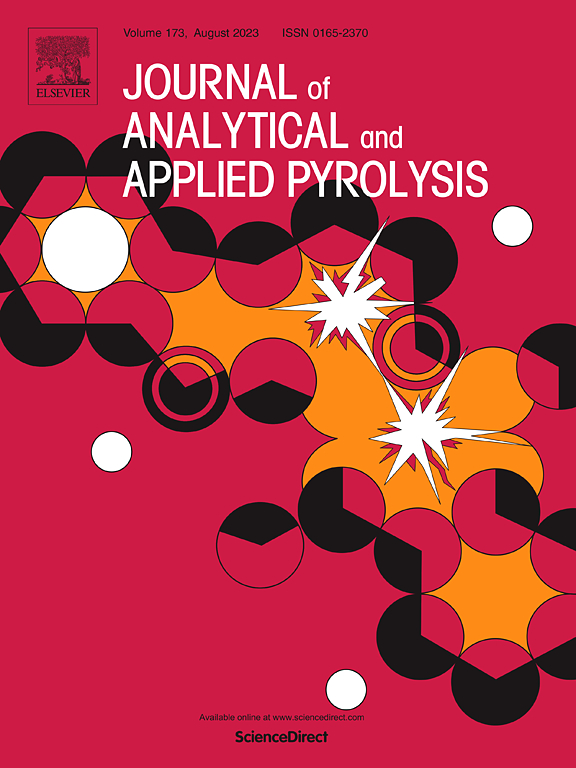Molecular structural evolution during coal oxidation based on in situ FTIR and Raman spectroscopy
IF 5.8
2区 化学
Q1 CHEMISTRY, ANALYTICAL
引用次数: 0
Abstract
The elucidation of surface functional groups and microcrystalline structures in coal is fundamental for exploring the advanced coal conversion processes and elaborate pollutant formation mechanisms. In this work, in situ Fourier transform infrared (FTIR) and in situ Raman spectroscopy were employed to characterize the evolution of surface functional groups and microcrystalline structures throughout the coal oxidation process. The results indicate that oxidation causes the decomposition of -OH and -COOH, an increase in C-O functional group content, and the cleavage of C![]() C bonds at high temperatures. As the temperature rises, aromaticity parameters (fa, I) and condensation degree (DOC) generally increase, while the structural parameter ‘C’ for oxygen-containing groups decreases. Furthermore, Raman parameters show an increase in AD/AG (proportion of large disordered aromatic rings) and a decrease in A(GR+VL+VR)/AD (relative content of 3–5 ring aromatic hydrocarbons), which corroborate the FTIR aromaticity parameters. These results suggest that during the oxidation process, condensation reactions and aromatization of aromatic rings occur, resulting in a general rise in aromaticity. In addition, the anthracite HN coal undergoes significant graphitization at 500°C. Notably, during the comminution process, mechanical forces introduce an increase in -OH, C
C bonds at high temperatures. As the temperature rises, aromaticity parameters (fa, I) and condensation degree (DOC) generally increase, while the structural parameter ‘C’ for oxygen-containing groups decreases. Furthermore, Raman parameters show an increase in AD/AG (proportion of large disordered aromatic rings) and a decrease in A(GR+VL+VR)/AD (relative content of 3–5 ring aromatic hydrocarbons), which corroborate the FTIR aromaticity parameters. These results suggest that during the oxidation process, condensation reactions and aromatization of aromatic rings occur, resulting in a general rise in aromaticity. In addition, the anthracite HN coal undergoes significant graphitization at 500°C. Notably, during the comminution process, mechanical forces introduce an increase in -OH, C![]() C, and C
C, and C![]() O content on coal surfaces, while C-O content decreases. Additionally, the reduction in particle size partially inhibits coal oxidation reactions in the initial stages, whilst accelerates the maturation of the aromatic system and the trend toward graphitization. These findings offer a theoretical foundation for analyzing the homogeneous and heterogeneous reduction mechanisms of NOx, and developing low-NOx combustion technologies.
O content on coal surfaces, while C-O content decreases. Additionally, the reduction in particle size partially inhibits coal oxidation reactions in the initial stages, whilst accelerates the maturation of the aromatic system and the trend toward graphitization. These findings offer a theoretical foundation for analyzing the homogeneous and heterogeneous reduction mechanisms of NOx, and developing low-NOx combustion technologies.
基于原位FTIR和拉曼光谱的煤氧化过程中的分子结构演化
阐明煤的表面官能团和微晶结构是探索煤的高级转化过程和阐述污染物形成机制的基础。本文采用原位傅立叶变换红外(FTIR)和原位拉曼光谱技术,对煤氧化过程中表面官能团和微晶结构的演变进行了表征。结果表明,高温氧化导致-OH和-COOH分解,C-O官能团含量增加,CC键断裂。随着温度的升高,芳香性参数(fa, I)和缩合度(DOC)普遍升高,含氧基团的结构参数“C”降低。Raman参数显示,大无序芳环比例AD/AG增加,3-5环芳烃相对含量a (GR+VL+VR)/AD降低,与FTIR芳香性参数一致。这些结果表明,在氧化过程中,发生了缩合反应和芳香环的芳构化,导致芳香性普遍升高。此外,无烟煤HN煤在500℃时发生了明显的石墨化。值得注意的是,在粉碎过程中,机械力使煤表面的-OH、CC和CO含量增加,而C-O含量降低。此外,颗粒尺寸的减小在一定程度上抑制了煤的初始氧化反应,同时加速了芳香体系的成熟和石墨化趋势。这些发现为分析NOx均相和非均相还原机理以及开发低NOx燃烧技术提供了理论基础。
本文章由计算机程序翻译,如有差异,请以英文原文为准。
求助全文
约1分钟内获得全文
求助全文
来源期刊
CiteScore
9.10
自引率
11.70%
发文量
340
审稿时长
44 days
期刊介绍:
The Journal of Analytical and Applied Pyrolysis (JAAP) is devoted to the publication of papers dealing with innovative applications of pyrolysis processes, the characterization of products related to pyrolysis reactions, and investigations of reaction mechanism. To be considered by JAAP, a manuscript should present significant progress in these topics. The novelty must be satisfactorily argued in the cover letter. A manuscript with a cover letter to the editor not addressing the novelty is likely to be rejected without review.

 求助内容:
求助内容: 应助结果提醒方式:
应助结果提醒方式:


